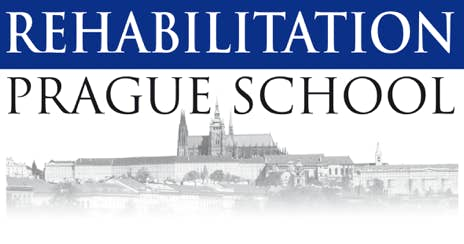Course B Review
Dynamic Neuromuscular Stabilisation Course B 2009
Rehabilitation Department, Charles University, Motol Hospital, Prague.
By Roger Kingston DO
I found a reference to Pavel Kolar in Craig Liebenson’s book “Rehabilitation of the Spine” and was fascinated. Subsequently I spent a week in rural Denmark studying an introduction to DNS. DNS or Dynamic Neuromuscular Stimulation is the work of Professor Pavel Kolar and colleagues at the Prague School of Manual Medicine and Rehabilitation, an institution that has been associated with Karel Lewitt, Vladamir Janda and Vaclav Vojta all huge names in the field of Rehabilitation.
Professor Karel Lewit, “Rehabilitation of the Motor System”, now in his 93 year, at the age of 85 stated that Pavel Kolar’s approach was “in his opinion far superior to his own and was clearly the way ahead”.
In May I went to Prague, in the Czech Republic, to undertake further training at Motol Hospital the teaching hospital, which is attached to Charles University. I fellow students were Chiropractors and Physiotherapists from India, Italy, Scandinavia, Canada and Spain. Once again I was the only Osteopath!
My first day was spent observing in the clinic, one case in particular, a female opera singer with an ACL rupture was being rehabilitated pre-surgery. Her physiotherapist was keen to explain the neuro-physiological interrelationship between her brain, posture, respiratory stereotype, singing mechanics and the rehabilitation of her knee prior to surgery. His understanding and how he instituted physical change through DNS stimulation was amazing and he spent little time working with the knee.
So what exactly is DNS and how does it work? Ok here goes ……………
DNS is a rehabilitation strategy based upon the inter-relationship of the developing child and the neuro-physiological maturation of the postural-locomotor system. The maturation of the post-partum central nervous system and muscle function is related to anatomical maturation / morphological development. Postural activity occurs automatically in the course of CNS maturation via coordinated activity of the muscles.
Postural Ontogenesis defines ideal posture from a developmental perspective whereby optimal muscle coordination is ideal for joint loading and defines ideal motor stereotypes. The process is genetically determined and is automatic. At the age of 4.5 months, stabilization of the spine, pelvis and chest in the sagittal plane are completed. Completion of basic sagittal stabilization is followed by development of extremity movement patterns (i.e. supporting and stepping forward /grasping functions) coupled with trunk rotation. As such, the quality of torso stabilization is essential for any phasic (dynamic) movement since each movement is preceded with the stabilization of body segments to provide balance, efficient coordination and stability to its participating elements.
DNS diagnosis is based on comparing the patient’s stabilizing pattern with the stabilization developmental pattern of a healthy baby. The treatment approach emphasizes the training of these ideal patterns as defined by developmental theory. The brain must be properly stimulated and conditioned to automatically activate optimal movement patterns that are necessary for the co-activation of the stabilizers. The ultimate strategy is to teach the brain to maintain central control and stability of the movement restored during the therapy. This can be achieved by activation of the stabilizers when placing the patient in the primal developmental positions.
DNS is a complex approach, encompassing principles of developmental theory during the 1st year of human life, defining posture, breathing stereotype and functional joint centration from a “neurodevelopmental” paradigm.
Ok so how does this help me as an Osteopath?
The etiology of back pain should be investigated not only from an anatomical and biomechanical perspective, evaluating influence of external forces acting on the spine, but should also include evaluation of the internal forces induced by the patient’s own musculature.
Activation of the stabilizing muscles is automatic and subconscious, preceding every purposeful (or dynamic) movement. The integrated stabilizing system of the spine consists of well-balanced activity between deep neck flexors and spinal extensors in the cervical and upper thoracic region. Stability of the lower thoracic and lumbar region is dependent on the proportional activity between the diaphragm, pelvic floor, all the sections of the abdominal wall and spinal extensors.
Under pathological conditions, insufficient postural function of the diaphragm, abnormal recruitment and timing between diaphragmatic and abdominal muscles activity, abnormal initial chest position and hyperactivity of the superficial spinal extensors can usually be observed.
Hence no spinal or peripheral joint problem can be adequately treated and stabilised without the patient having a normally functioning and stabile CNS / Musculoskeletal relationship – now that’s Osteopathy!
Kolar’s approach to Dynamic Neuromuscular Stabilization (DNS) explains the importance of the above muscular interactions and their proper recruitment for dynamic stability of the spine and utilizes a series of systematic dynamic tests. The treatment approach is based on reflex locomotion principles and ontogenetic postural locomotor patterns. The primary goal of this treatment approach is to optimize distribution of internal forces of the muscles acting on each segment of the spine and/or any other joint.
But I only want to treat children or sports injuries!
Professor Kolar is a specialist in paediatric rehabilitation, especially in brain injured neonates, he is an expert in neuromuscular assessment and in the physical treatment of these babies to give them the opportunity to recover to a degree. His work with developmental delay and coordination dysfunction in children is equally fascinating.
He is the Czech Olympic team Dr. His knowledge of human biomechanical function and how to correct dysfunction is unparalleled.
When President Vaclav Havel travelled abroad Pavel Kolar accompanied him to keep him alive! Havel had lung cancer and pneumonia and Kolar with his DNS approach was able to keep his remaining lung functional.
Has it been of any use in practice?
Hugely so! I have found it indispensable in treating babies and children with scoliosis, chronic constipation, asthma and postural dysfunction. In adults unstable spinal patterns improve and patients stay out of pain. I certainly would not want to be with out this approach in my toolkit.
Prague is only 90 minutes away by plane and is a beautiful, historical city and compared to the costs of CPD in the UK is probably cheaper. The European School of Osteopathy is hosting an introduction to DNS in early January 2010, I strongly urge you to attend.
Roger Kingston DO


